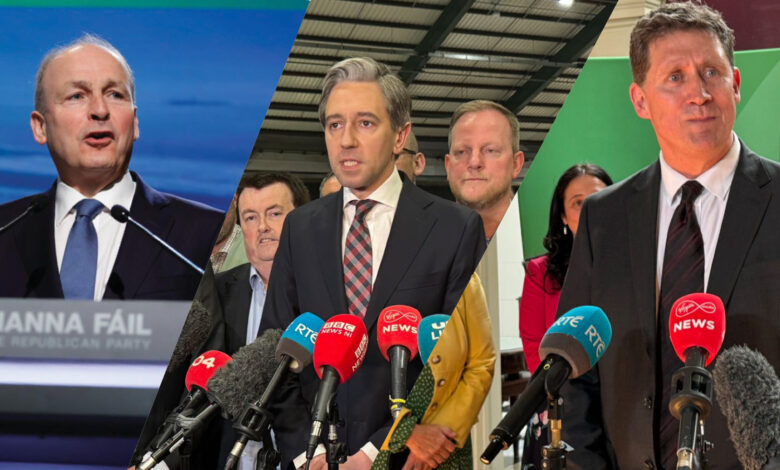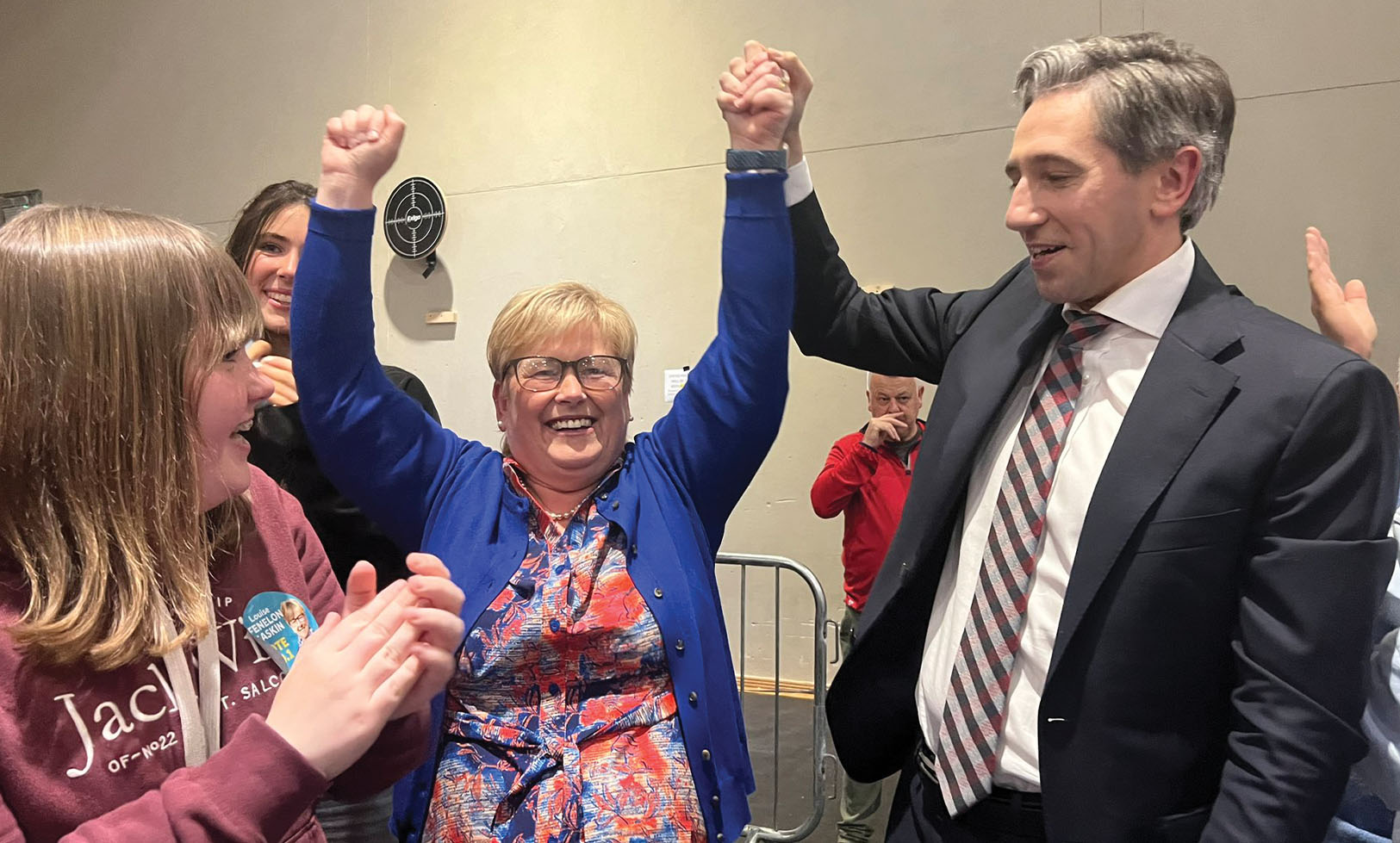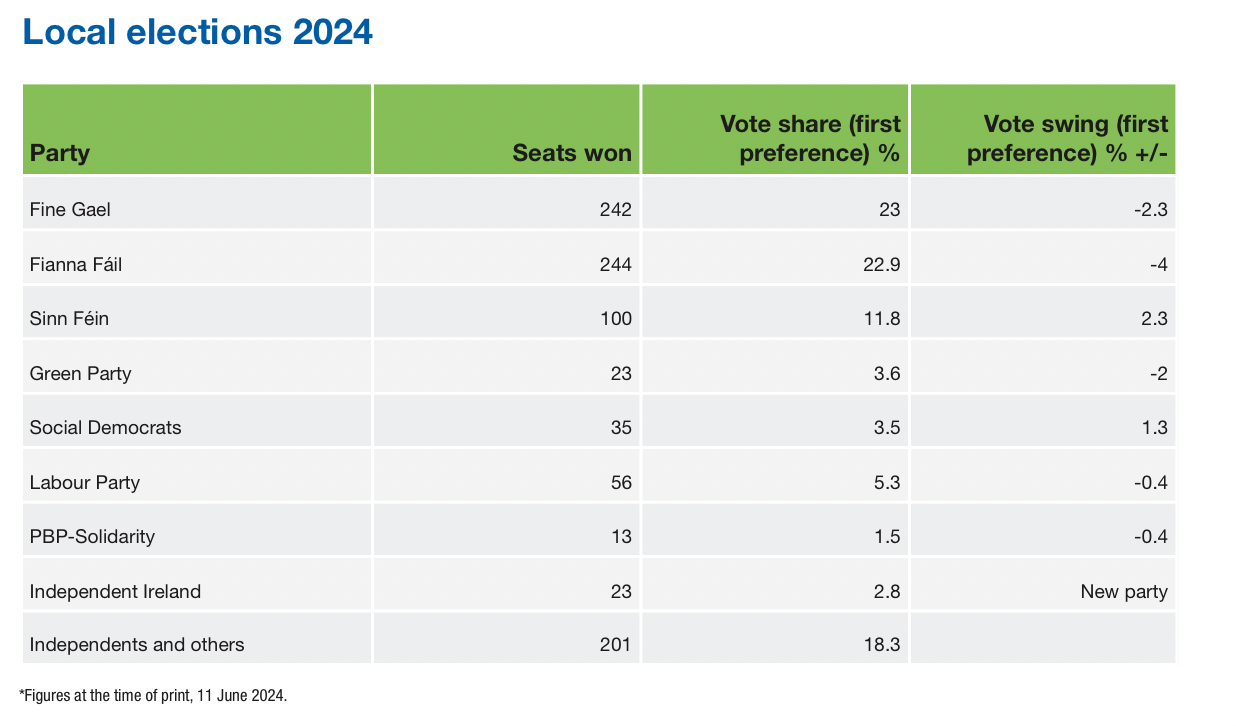Local elections 2024: Government parties reassert themselves and Sinn Féin misses its opportunity

The 2024 local elections have presented the ultimate paradox: Although the government parties have all recorded declines in their share of first-preference votes and lost seats, and the main opposition party has gained votes and seats, the Government parties are the undoubted winners and Sinn Féin is the undoubted loser of this election. Joshua Murray reflects on the 2024 local election results.
At the time of print, Fine Gael is confirmed to have won the popular vote on 23 per cent, ahead of Fianna Fáil by less than 1,000 votes State-wide, while Fianna Fáil is likely to emerge as the largest party by seats won for the third consecutive local election. The local elections have been disappointing for Sinn Féin, strong for independents, and satisfactory for other Oireachtas parties.
While there has been no shift towards support for the Government – with Fine Gael, Fianna Fáil and the Green Party generally either consolidating their existing seats and recording marginal losses – there has been a fragmentation in support for the opposition, with support expressed in opinion polls shifting away from Sinn Féin and predominantly towards independents and, albeit on a smaller scale, smaller parties.
Local elections differ from general elections in that there is a need for much more nuance in political strategy than in general elections, and this partially explains why Fine Gael and Fianna Fáil, the parties with established networks, members, and a history of victory, have managed to navigate the complicated course of council elections so successfully. It is a dynamic often defines by personality over party.
This has been an election where apathy has arguably been the true winner, with a total turnout of 49.3 per cent recorded at the time of writing, among the lowest ever in the history of local elections in the State. While people who voted for government parties will be generally satisfied in policies being rolled out by the coalition parties (albeit without those parties attracting any new support), the opposition has not been able cohesively to motivate those disaffected or unaligned voters.
Interesting is that the differentiation in turnout in the 2020 general election (62.9 per cent) and the local elections – a gap of 13.6 per cent – mirrors closely with the level of Sinn Féin’s underperformance in the local elections compared with opinion polling (the party had been polling on average at 25 per cent prior to voting). Essentially, it is possible that many who voted for Sinn Féin in 2020 stayed at home in 2024, while most of those who voted for Fine Gael, Fianna Fáil, and the Green Party came out to vote for them again.
The Government parties have interpreted the results as a vote in confidence, with Taoiseach Simon Harris TD asserting that “the Irish people do not believe they live in a failed state… The Irish people do not believe in all of the negativity and the ‘rah rah rah’ but [what] the Irish people want is pragmatic delivery”.
Although Fine Gael has positioned itself strongly in these elections under its new leader, the Taoiseach says he is no rush to take his party’s success to back to the people before the end of the Government’s term in March 2025.
“The Irish people do want change. They want credible change. That is the sort of change I am offering with Fine Gael and our coalition colleagues.
“[The public] want me to bring energy not just to the campaign trail, but to also solving some issues, including ones that have seemed intractable in the past, and that’s my absolute determination.”
Fine Gael also emerged as the largest party in Dublin City Council for the first time ever, giving the new Taoiseach a further confidence boost. However, by vote share, Fine Gael has in fact recorded its lowest vote share in a local election since 1991.
Tánaiste and Fianna Fáil leader was keen to play up the election as being about the “Sinn Féin collapse”, a characterisation which is not technically true as Sinn Féin has not ‘collapsed’, but underperformed.
For the Fianna Fáil leader, the election was a case of consolidation and, at the time of print, the party stands a chance of a poll-topping local election for the third consecutive time. Fianna Fáil’s 22.9 per cent is hardly a vintage performance for the once-dominant party, but Martin currently stands as the most popular political leader in the State and he was satisfied that the party’s performance was “better than expected”, in spite of this technically being Fianna Fáil’s worst ever local election results by popular vote.
Martin was keen to emphasise that “local election results do not correlate with general election results”, and effectively unveiled the plans for the remainder of this government’s term, stating that he wants to see “an effective budget”, mirroring comments by his coalition counterpart Simon Harris that the Government will see out its term until March 2025.
Minister for Housing Darragh O’Brien said Fianna Fáil was “satisfied” with the party’s performance and that government parties had done “much better than predicted”.
Fianna Fáil has largely held out in rural Ireland, but this success has been mirrored with flickers of disappointment with the party coming in fifth place in Dublin City Council, a chamber where it was the largest party prior to polling.
Nevertheless, Martin has once again defied the odds to deliver a better-than-expected result for Fianna Fáil, and he will be hopeful that with some new faces emerging (including a new generation of the Haughey family) from these local elections, that Fianna Fáil will be able to springboard some of them into the Dáil when the people vote in the next 10 months.
Sinn Féin underperformance
Undoubtedly the most dominant theme is Sinn Féin’s massive underperformance and misjudgement in this election. The joint-largest party in the Dáil, Sinn Féin had hoped to more than double its seats in local government but has remained a disappointing third place (fourth if you include independents) and polled around half of both Fine Gael and Fianna Fáil, and less than one-quarter of the combined total of the Civil War parties.
Sinn Féin president Mary Lou McDonald TD went to great pains to stress that her party would run enough candidates to emerge as the largest party in local government, however, although the party has made modest gains on its 2019 results (19 more seats at the time of print), these results are disastrous for a party which is aiming to lead government in the next year.
The party is set to win around 12 per cent of the popular vote, meaning it has barely improved on its results from 2019 (9.48 per cent) – an election which was perceived as disastrous for Sinn Féin – and stands significantly below its 2014 results (15.2 per cent) when the party was led by Gerry Adams.
In Dublin City Council, where the party was aiming to become the largest party (a feat it achieved in 2014), Sinn Féin made only one gain and came third, behind Fianna Fáil and the Social Democrats.
McDonald has ruled out resigning as leader of Sinn Féin, and has stated that the party will “regroup” and “reflect”, acknowledging that while “we have made modest gains”, that “we haven’t had the sort of day we had hoped for”.
While McDonald helped sweep Sinn Féin to a shock poll-topping performance in the 2020 general election, and the party continues to perform strongly in the North, Sinn Féin has now – in two local elections and two European elections – significantly underperformed. However, it is worth remembering that in 2019, McDonald’s leadership was also under question after the last local election results. Sinn Féin followed this up with a general election victory (by popular vote) only nine months later.
Unlike the other main parties, Sinn Féin has the immediate task of refocusing its energy for the Westminster general election in the North on 4 July 2024. After this however, the party has a similar timescale – with a general election by March 2025 at the latest – to turn back the tide, and arguably McDonald’s future leadership of the party will depend on a rebound in support for the next general election.

Opposition realignment
The story of swings in this election has been a potential realignment within opposition, with the swing away from the government parties falling into the hands of independents and smaller swings to the Social Democrats and Independent Ireland.
Independents have been the victors outside of the Government parties, with independents (along with minor parties) willing over 28 per cent of the vote, a figure which, if replicated in a general election, would undoubtedly result in them having an important role in government affairs, a phenomenon which has manifested in the current Dáil with a number of independents voting for the Government in confidence motions.
The ideology of these independents elected varies significantly, with one far-right activist elected in Dublin, while in the southwest three members of the Healy-Rae family were elected to Kerry County Council as localist candidates.

The Green Party has lost a considerable amount of its popular vote, and is down on its 49 seats won in 2019, but according to Ciarán Cuffe, who himself is hoping to retain his MEP seat for Dublin, the Green Party “did not get the kicking” that was predicted.
Under the radar has been the rise of the Social Democrats, who have almost doubled their 19 councillors won in 2019, and are an undoubted presence in Irish politics. The Social Democrats even emerged in second place in Dublin City Council, ahead of both Sinn Féin and Fianna Fáil. Their performance is so profound that former Labour Party leader Pat Rabbitte has called for a merger between the two parties, a move which has been repeatedly ruled out by Social Democrats’ leader Holly Cairns TD.
23 members of Independent Ireland, a new right-wing party led by three TDs elected as independents have been elected to councils, a significant achievement in what was the party’s first election.
Elsewhere, the Labour Party and People Before Profit-Solidarity recorded some gains, particularly around Dublin, and both will be satisfied with their results in what was broadly a difficult election for the left.
Despite polling showing that immigration was to come to the fore as a political topic, and with significant number of candidates on the far-right running, only two candidates for far-right parties won any seats, and while independents – including many who are socially conservative – have been elected, a minimal number of these were elected on a far-right or anti-immigrant ticket.
General election to come
If these results were to remanifest, both in terms of respective vote share and turnout, in a general election, than the three party leaders would be almost certain of reassuming their roles in government beyond March 2025.
However, the general election will bring housing back to the fore as a topic of discussion in a manner not possible in a local election, and turnout will also be significantly higher, meaning that although this has been an encouraging election for the Government, there remains a lot of uncertainty as to whether the ‘grand coalition’ will maintain its presence in Government Buildings.
This issue of eolas Magazine went to print on 11 June 2024.





